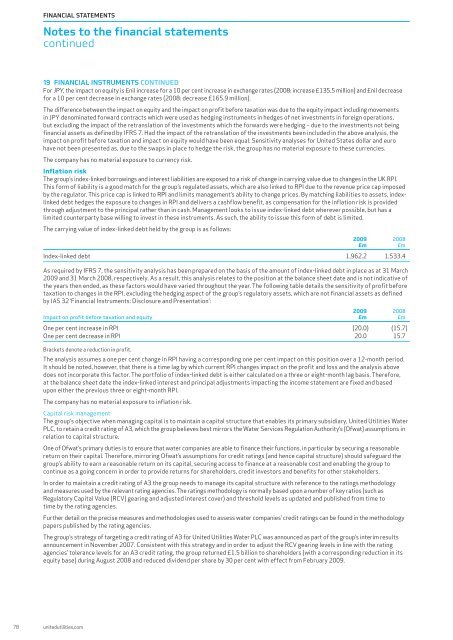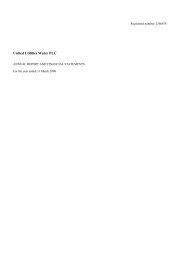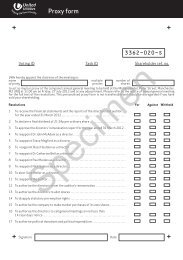Annual report and financial statement 2009 - United Utilities
Annual report and financial statement 2009 - United Utilities
Annual report and financial statement 2009 - United Utilities
You also want an ePaper? Increase the reach of your titles
YUMPU automatically turns print PDFs into web optimized ePapers that Google loves.
FINANCIAL STATEMENTSNotes to the <strong>financial</strong> <strong>statement</strong>scontinued19 FINANCIAL INSTRUMENTS CONTINUEDFor JPY, the impact on equity is £nil increase for a 10 per cent increase in exchange rates (2008: increase £135.5 million) <strong>and</strong> £nil decreasefor a 10 per cent decrease in exchange rates (2008: decrease £165.9 million).The difference between the impact on equity <strong>and</strong> the impact on profit before taxation was due to the equity impact including movementsin JPY denominated forward contracts which were used as hedging instruments in hedges of net investments in foreign operations,but excluding the impact of the retranslation of the investments which the forwards were hedging – due to the investments not being<strong>financial</strong> assets as defined by IFRS 7. Had the impact of the retranslation of the investments been included in the above analysis, theimpact on profit before taxation <strong>and</strong> impact on equity would have been equal. Sensitivity analyses for <strong>United</strong> States dollar <strong>and</strong> eurohave not been presented as, due to the swaps in place to hedge the risk, the group has no material exposure to these currencies.The company has no material exposure to currency risk.Inflation riskThe group’s index-linked borrowings <strong>and</strong> interest liabilities are exposed to a risk of change in carrying value due to changes in the UK RPI.This form of liability is a good match for the group’s regulated assets, which are also linked to RPI due to the revenue price cap imposedby the regulator. This price cap is linked to RPI <strong>and</strong> limits management’s ability to change prices. By matching liabilities to assets, indexlinkeddebt hedges the exposure to changes in RPI <strong>and</strong> delivers a cashflow benefit, as compensation for the inflation risk is providedthrough adjustment to the principal rather than in cash. Management looks to issue index-linked debt wherever possible, but has alimited counterparty base willing to invest in these instruments. As such, the ability to issue this form of debt is limited.The carrying value of index-linked debt held by the group is as follows:<strong>2009</strong> 2008£m £mIndex-linked debt 1,962.2 1,533.4As required by IFRS 7, the sensitivity analysis has been prepared on the basis of the amount of index-linked debt in place as at 31 March<strong>2009</strong> <strong>and</strong> 31 March 2008, respectively. As a result, this analysis relates to the position at the balance sheet date <strong>and</strong> is not indicative ofthe years then ended, as these factors would have varied throughout the year. The following table details the sensitivity of profit beforetaxation to changes in the RPI, excluding the hedging aspect of the group’s regulatory assets, which are not <strong>financial</strong> assets as definedby IAS 32 ‘Financial Instruments: Disclosure <strong>and</strong> Presentation’:<strong>2009</strong> 2008Impact on profit before taxation <strong>and</strong> equity £m £mOne per cent increase in RPI (20.0) (15.7)One per cent decrease in RPI 20.0 15.7Brackets denote a reduction in profit.The analysis assumes a one per cent change in RPI having a corresponding one per cent impact on this position over a 12-month period.It should be noted, however, that there is a time lag by which current RPI changes impact on the profit <strong>and</strong> loss <strong>and</strong> the analysis abovedoes not incorporate this factor. The portfolio of index-linked debt is either calculated on a three or eight-month lag basis. Therefore,at the balance sheet date the index-linked interest <strong>and</strong> principal adjustments impacting the income <strong>statement</strong> are fixed <strong>and</strong> basedupon either the previous three or eight-month RPI.The company has no material exposure to inflation risk.Capital risk managementThe group’s objective when managing capital is to maintain a capital structure that enables its primary subsidiary, <strong>United</strong> <strong>Utilities</strong> WaterPLC, to retain a credit rating of A3, which the group believes best mirrors the Water Services Regulation Authority’s (Ofwat) assumptions inrelation to capital structure.One of Ofwat’s primary duties is to ensure that water companies are able to finance their functions, in particular by securing a reasonablereturn on their capital. Therefore, mirroring Ofwat’s assumptions for credit ratings (<strong>and</strong> hence capital structure) should safeguard thegroup’s ability to earn a reasonable return on its capital, securing access to finance at a reasonable cost <strong>and</strong> enabling the group tocontinue as a going concern in order to provide returns for shareholders, credit investors <strong>and</strong> benefits for other stakeholders.In order to maintain a credit rating of A3 the group needs to manage its capital structure with reference to the ratings methodology<strong>and</strong> measures used by the relevant rating agencies. The ratings methodology is normally based upon a number of key ratios (such asRegulatory Capital Value (RCV) gearing <strong>and</strong> adjusted interest cover) <strong>and</strong> threshold levels as updated <strong>and</strong> published from time totime by the rating agencies.Further detail on the precise measures <strong>and</strong> methodologies used to assess water companies’ credit ratings can be found in the methodologypapers published by the rating agencies.The group’s strategy of targeting a credit rating of A3 for <strong>United</strong> <strong>Utilities</strong> Water PLC was announced as part of the group’s interim resultsannouncement in November 2007. Consistent with this strategy <strong>and</strong> in order to adjust the RCV gearing levels in line with the ratingagencies’ tolerance levels for an A3 credit rating, the group returned £1.5 billion to shareholders (with a corresponding reduction in itsequity base) during August 2008 <strong>and</strong> reduced dividend per share by 30 per cent with effect from February <strong>2009</strong>.78 unitedutilities.com
















